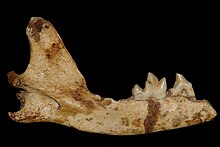Vulpes skinneri
| Vulpes skinneri Temporal range: Pleistocene
| |
|---|---|

| |
| Mandible of type specimen | |
| Scientific classification | |
| Domain: | Eukaryota |
| Kingdom: | Animalia |
| Phylum: | Chordata |
| Class: | Mammalia |
| Order: | Carnivora |
| Family: | Canidae |
| Genus: | Vulpes |
| Species: | †V. skinneri
|
| Binomial name | |
| †Vulpes skinneri Adam Hartstone-Rose et al., 2013[1]
| |
Vulpes skinneri is a species of extinct
Discovery
The type specimen of V. skinneri was discovered during preparation of fossil bearing blocks from Malapa. The find was announced to the public on January 16, 2013. Also found at the

Age estimates
The fossil was dated using a combination of
Morphology and interpretations

Three associated small canid specimens (an M2, a rib and a posterior mandibular fragment including the P4, M1, coronoid, condylar and angular processes) that were originally attributed to Vulpes cf. V. chama are reassigned to V. skinneri. In the paper describing the new specimens, the authors argue that “we compare these specimens to a broad sample of modern and fossil foxes and conclude that these specimens are distinct enough to be referred to a new species”[1] of the early Pleistocene, identified based on fossil remains dated to about 2 million years ago.[2]
References
External links
- Hartstone-Rose, Adam; Kuhn, Brian F.; Nalla, Shahed; Werdelin, Lars; Berger, Lee R. (2013). "A new species of fox from the Australopithecus sedibatype locality, Malapa, South Africa". Transactions of the Royal Society of South Africa. 68: 1–9. S2CID 84695745.
- "Carnivore fossils from Malapa" (PDF). )</ref>
- "Images and Pictures of Australopithecus sediba and Malapa". Archived from the original on 2011-07-15. Free images and resources about "Australopithecus sediba" for educators and students]
